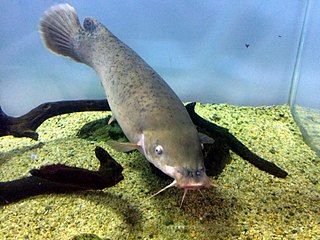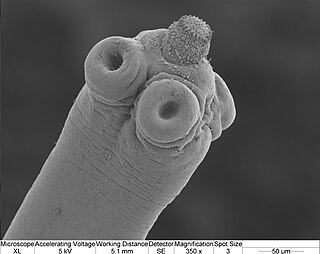The slender argentine, Microstoma microstoma, is a species of pencil smelt, found around the world in tropical and subtropical areas. This species grows to a length of 21 centimetres (8.3 in) TL. Its main food includes other fish, and its feces.

The sicklefin weasel shark is an uncommon species of ground shark in the family Hemigaleidae. It is native to southern India, southern China, and parts of Southeast Asia, living in shallow waters down to a depth of 170 m (560 ft). This lightly built shark is characterized by its very short mouth, broad upper teeth with serrations only on the trailing edge, and strongly sickle-shaped fins with obvious white tips on the two dorsal fins. It is light grey or bronze in colour, often with small white blotches on its sides; it reaches a maximum known length of 1.1 m (3.6 ft).
Ophryophryne is a genus of amphibian in the family Megophryidae from Southeast Asia. They are sometimes known as mountain toads.
Ophryophryne microstoma is a species of amphibian in the family Megophryidae. It is found in Cambodia, China, Laos, Thailand, and Vietnam. Its natural habitats are subtropical or tropical moist lowland forests, subtropical or tropical moist montane forests, rivers, and swamps. It is threatened by habitat loss.
The littletooth sandeater is a species of cichlid endemic to Lake Malawi where it is known from sandy areas around Cape Maclear and in Senga Bay. This species grows to a length of 14.5 centimetres (5.7 in) TL. It can also be found in the aquarium trade.
Trematocranus microstoma, known in the aquarium trade as the "Haplochromis placodon pointed head" is a species of cichlid endemic to Lake Malawi where it is found in shallow waters close to shore, apparently showing a preference for areas with plentiful vegetation. This species can reach a length of 23.2 centimetres (9.1 in) TL. This species can also be found in the aquarium trade.
Tropheops microstoma is a species of cichlid fish endemic to Lake Malawi where it prefers sheltered bays with calm waters. This species can reach a length of 9.8 centimetres (3.9 in) SL. It can also be found in the aquarium trade.
Lamellidea microstoma is a species of air-breathing tropical land snails, terrestrial pulmonate gastropod mollusks in the family Achatinellidae. This species is found in Guam and the Northern Mariana Islands.
Partula microstoma was a species of air-breathing tropical land snail, a terrestrial pulmonate gastropod mollusk in the family Partulidae. This species was endemic to French Polynesia. It is now extinct.
Macropinna microstoma is the only species of fish in the genus Macropinna, belonging to the Opisthoproctidae, the barreleye family. It is recognized for a highly unusual transparent, fluid-filled dome on its head, through which the lenses of its eyes can be seen. The eyes have a barrel shape and can be rotated to point either forward or straight up, looking through the fish's transparent dome. M. microstoma has a tiny mouth and most of its body is covered with large scales. The fish normally hangs nearly motionless in the water, at a depth of about 600 metres (2,000 ft) to 800 metres (2,600 ft), using its large fins for stability and with its eyes directed upward. In the low light conditions it is assumed the fish detects prey by its silhouette. MBARI researchers Bruce Robison and Kim Reisenbichler observed that when prey such as small fish and jellyfish are spotted, the eyes rotate like binoculars, facing forward as it turns its body from a horizontal to a vertical position to feed. Robison speculates that M. microstoma steals food from siphonophores.
This genus is characterized by a rounded snout and short gill slits. The mouth is short and broadly arched; the teeth have very short cusps, without toothless spaces at the jaw midlines. The dorsal and pelvic fins, and the lower caudal lobe are strongly falchate. At one time or another, this genus has encompassed up to nine species, but most were eventually split off into other genera. Neogaleus Whitley, 1931 is a junior synonym of this genus.

Malapterurus microstoma, the smallmouth electric catfish, is a species of electric catfish native to the Congo River basin of Central African Republic, the Democratic Republic of the Congo and the Republic of the Congo. This species grows to a length of 55.5 centimetres (21.9 in) SL. This fish can be found in the aquarium trade. It is illegal to possess any species of electric catfish for personal or commercial use in Florida.

Microstoma floccosum is a species in the Sarcoscyphaceae family of cup fungi. It is recognizable by its deep funnel-shaped, scarlet-colored fruit bodies bearing white hairs on the exterior. Found in the United States and Asia, it grows on partially buried sticks and twigs of oak trees.

Is It Possible? is a three-episode documentary television series on the Discovery Channel that features people, animals, technology, and other things that are real, but so unusual and surprising that they seem impossible.

Hymenolepis microstoma, also known as the rodent tapeworm, is an intestinal dwelling parasite. Adult worms live in the bile duct and small intestines of mice and rats, and larvae metamorphose in the haemocoel of beetles. It belongs to the genus Hymenolepis; tapeworms that cause hymenolepiasis. H. microstoma is prevalent in rodents worldwide, but rarely infects humans.
Microstoma is a genus of pencil smelt.

The small-mouth righteye flounder is a flatfish of the family Pleuronectidae. It is a demersal fish that lives on saltwater bottoms from depths of 304 metres (997 ft). Its natural habitat is the tropical waters of the southwest Pacific. It can grow up to 10 centimetres (3.9 in) in length.
Sargocentron microstoma, the fine-lined squirrelfish, slender squirrelfish or smallmouth squirrelfish, is a member of the family Holocentridae. It has a wide range throughout the Indo-Pacific from the Chagos Archipelago, Seychelles, and the Maldives to the Hawaiian Islands, Line Islands, and the Tuamotus Archipelago, north to the Ryukyu Islands and Bonin Islands, south to Austral Islands and throughout Micronesia. It lives near reefs usually at depths between 1–35 m (3.3–114.8 ft), but can be found as deep as 183 m (600 ft). During the day it hides in crevices, especially near Acropora and Pocillopora. It is a nocturnal predator, feeding on crustaceans, worms, and fishes. It can reach sizes of up to 20 cm (7.9 in) TL and has a venomous preopercle.
Acrossocheilus microstoma is a species of cyprinid fish native to freshwater in northwestern Vietnam. It has sometimes included in A. iridescens as a subspecies.







